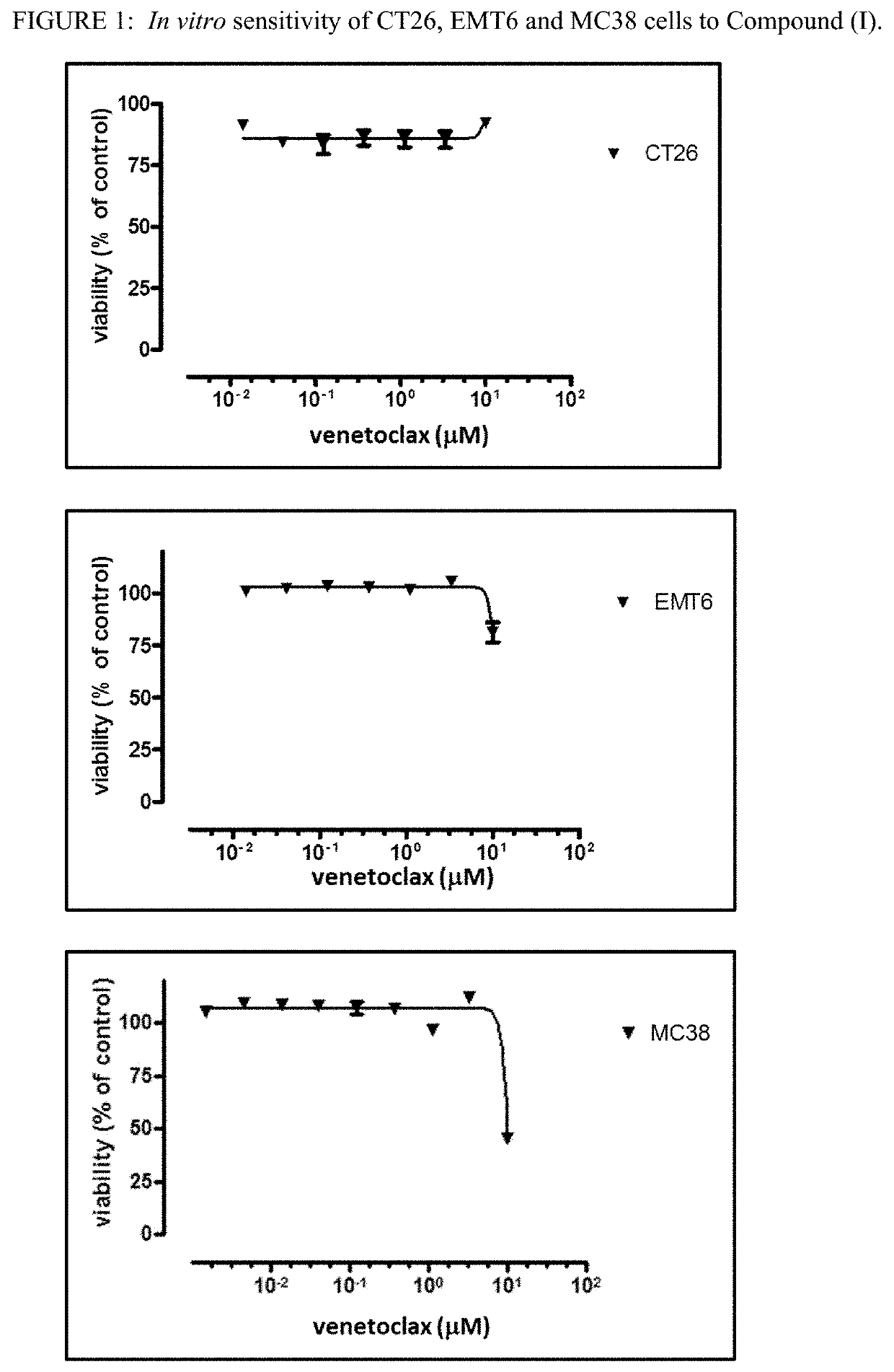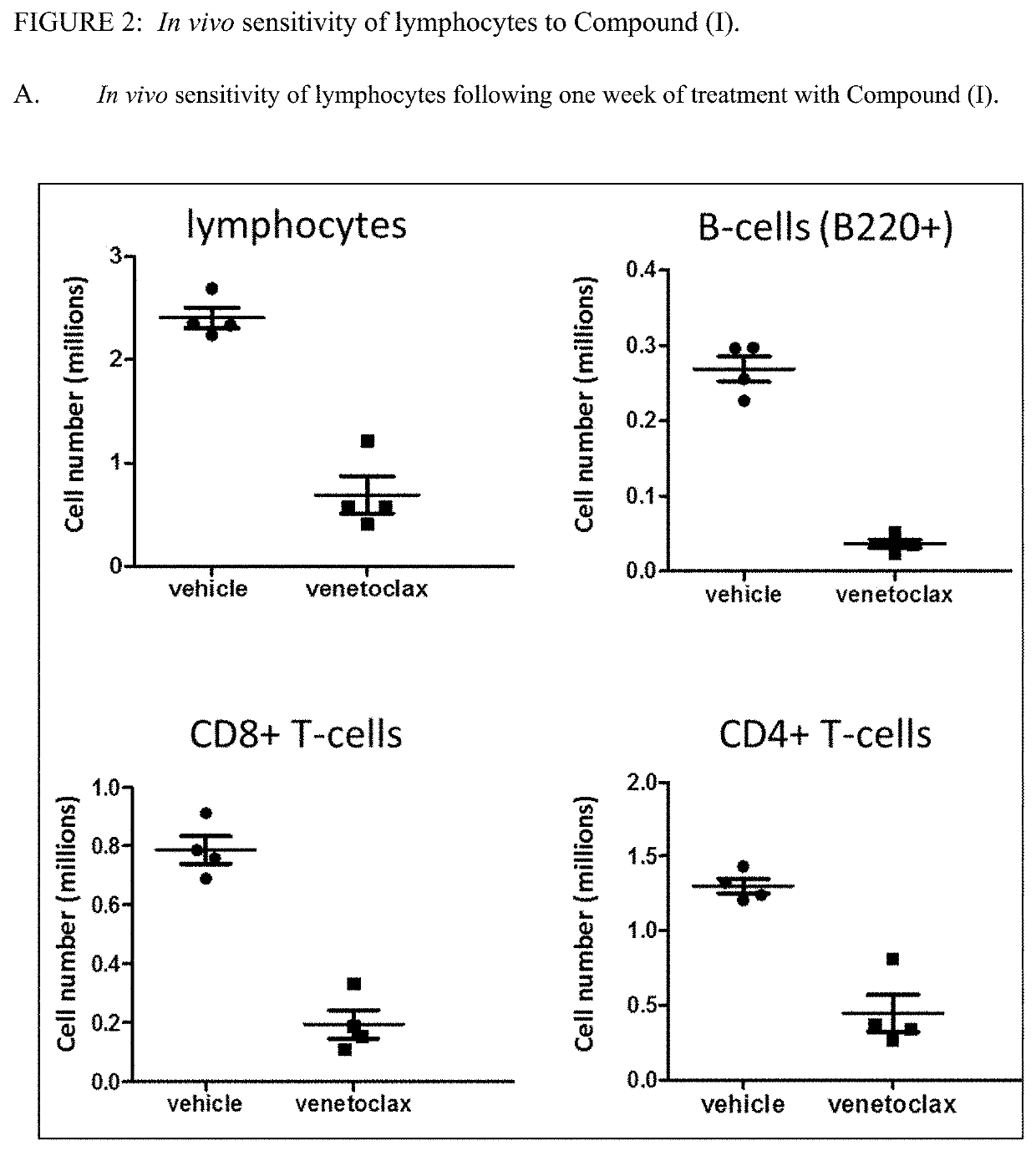Selective bcl-2 inhibitors in combination with an Anti-pd-1 or an Anti-pd-l1 antibody for the treatment of cancers
a bcl-2 inhibitor and anti-pd-1 technology, applied in the field of selective bcl2 inhibitors or prodrugs, can solve problems such as aberrant proliferation
- Summary
- Abstract
- Description
- Claims
- Application Information
AI Technical Summary
Benefits of technology
Problems solved by technology
Method used
Image
Examples
example 1
ics and Checkpoint Inhibitor Antibodies in Syngeneic Tumor Models
[0158]All experiments were conducted in compliance with the National Institutes of Health Guide for Care and Use of Laboratory Animals guidelines in a facility accredited by the Association for the Assessment and Accreditation of Laboratory Animal Care (AAALAC). BALB / c, C57BL / 6, CB6F1 (C57BL / 6 bred with BALB / c) and SCID mice were obtained from Charles River (Wilmington, Mass.). SCID mice have severe combined immune deficiency (SCID) and are characterized by an absence of functional T- and B-cells.
[0159]EMT6, mouse mammary carcinoma and CT26, mouse colon carcinoma, cell lines were obtained from ATCC (Manassas, Va.). MC38, mouse colon carcinoma cell line was obtained from National Cancer Institute (NCI).
[0160]Compound (I),venetoclax, was formulated in 10% ethanol+30% PEG 400+60% Phosal® 50PG. Venetoclax was administered orally once a day for 14 days at 50 mg / kg / day. Mouse anti-PD-1 antibody (anti mu PD1 (17D2 murinized, ...
example 1a
Treated with Compound (I)-Anti-PD-1 Antibody Combination
[0164]In the CT26 model, treatment with an anti-PD-1 antibody, anti mu PD1 (17D2 murinized, VH2xVL1x)[mu IgG2a / k] DANA, alone led to 32% tumor growth inhibition (TGI) and venetoclax alone led to 16% TGI whereas the anti-PD-1-venetoclax combination yielded a TGI of 49% (p3. To assess the immune response of these mice, spleens were collected from three groups of mice 10 days after inoculation: (1) naïve (non-tumor bearing) BALB / c, which serve as a control cohort, (2) primary CT26 tumor-bearing mice, mentioned above, and (3) mice that had complete response to anti-PD-1-venetoclax combination and remained tumor-free when re-inoculated with CT26 cells, mentioned above. Flow cytometry analysis of splenocytes showed an increase in the number of CD8+ T-cells with an effector memory phenotype (CD8+CD62L− CD44+) in complete responder mice that had been re-inoculated with CT26 (group 3) (FIG. 4).
[0165]To measure the ability of these splen...
example 1b
Treated with Compound (I)-Anti-PD-L1 Antibody Combination
[0167]In the EMT6 model of breast cancer, venetoclax had modest activity on its own but again led to an increased number of complete responses when combined with the anti-PD-L1 antibody, anti hu PD-L1 YW243.55.S70 [mu IgG2 a / k], (9 CRs for anti-PD-L1-venetoclax versus 3 CRs for anti-PD-L1 alone) (FIG. 6). Anti-PD-L1 antibody alone led to 89% TGI and the anti-PD-L1-venetoclax combination yielded a TGI of 94% (both p<0.05 relative to vehicle on day 25).
PUM
| Property | Measurement | Unit |
|---|---|---|
| Cell death | aaaaa | aaaaa |
Abstract
Description
Claims
Application Information
 Login to View More
Login to View More - R&D
- Intellectual Property
- Life Sciences
- Materials
- Tech Scout
- Unparalleled Data Quality
- Higher Quality Content
- 60% Fewer Hallucinations
Browse by: Latest US Patents, China's latest patents, Technical Efficacy Thesaurus, Application Domain, Technology Topic, Popular Technical Reports.
© 2025 PatSnap. All rights reserved.Legal|Privacy policy|Modern Slavery Act Transparency Statement|Sitemap|About US| Contact US: help@patsnap.com



